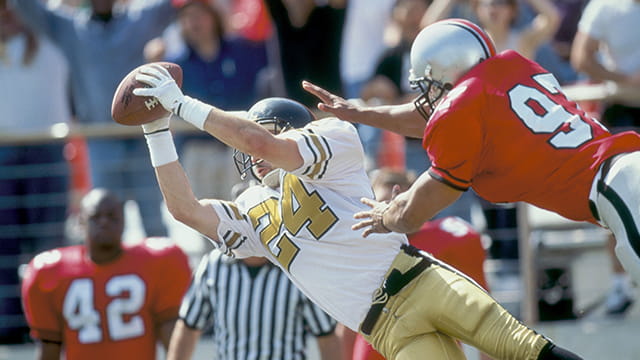Open Fracture Outcomes in the NFL: Study Finds High Likelihood of Return to Play
Jan. 25, 2023 - Eden McCleskeyNFL players who suffer an open fracture are likely to be able to return to play at the same level as before, but those with lower extremity fractures may have a harder time transitioning back than those with upper extremity fractures, a recent Houston Methodist study finds.
In the first study of its kind analyzing open fracture rates among NFL players, orthopedic researchers used publicly available records to analyze incidence of injury, return to sports (RTS) rate, RTS time, post-injury performance and career length for injured players and controls matched by age, experience, position and pre-injury performance.
"Overall, our findings indicate that despite the high energy and trauma involved in open fractures, these injuries did not have an effect on career length or performance," says Dr. Patrick McCulloch, vice chair of Orthopedic Surgery and a study co-author. "This information should reassure players that there is a high likelihood of resuming their professional careers after they have appropriately recovered."
Initially, the researchers had hypothesized that injured players would have a high RTS rate, significantly shorter post-injury career length and fewer games played per season than their matched controls, significantly worse post-injury performance scores compared with their pre-injury performance and significantly worse post-injury performance when compared to matched controls.
Surprisingly, only the first hypothesis proved true. A total of 30 players out of 37 (81%) were able to RTS in the NFL after their injury. Players who sustained open fractures had similar games played per season, career length and performance compared with matched controls. Post-injury performance scores for injured players were similar to their pre-injury performance scores.
Significant differences emerged when the researchers compared outcomes of players with lower extremity fractures to those with upper extremity fractures.
Lower extremity fractures resulted in significantly longer RTS time than upper extremity fractures (14 months vs. 4 months, P = .00007). The RTS rate for players sustaining an upper extremity fracture was 88% vs. 75% for lower extremity open fractures.
Player performance score was calculated using a standardized scoring system based on metrics important to the player's specific position (QB: passing/rushing yards, passing/rushing touchdowns; RB/WR/TE: receiving/rushing yards, receiving/rushing touchdowns; defense: tackles, assists, interceptions, fumbles, etc.).
Players in the upper extremity fracture group performed significantly better post-injury compared to their lower extremity fracture counterparts (6.4 vs. 3.3, P = .03).
Lower extremity fractures were slightly more common (54%) than upper extremity fractures. The most frequent injuries were to the tibia/fibula (43.2%), hand/finger (34.2%), humerus (8.1%) and forearm (8.1%).
When categorized by position, the largest number of open fractures occurred in wide receivers (n = 10), defensive backs (n = 7), quarterbacks (n = 5) and running backs (n = 5). These positions may be at increased risk for open fracture due to repetitive jumping and landing and moving at increased speeds before collision.


